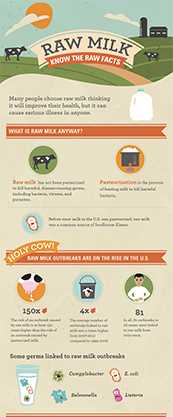Trying to Decide about Raw Milk?
A healthy lifestyle involves many decisions and steps. One step you might be deciding about is adding raw milk to your diet. Some people think about drinking raw milk because they want to eat fewer processed foods or they want to support local farmers and sustainable agriculture. Others think about drinking raw milk because they heard claims that raw milk is better for their health. Yet, raw milk can be a home for bacteria and other germs that can cause people to become ill.
Harmful germs usually don’t change the look, taste, or smell of milk, so only when milk has been pasteurized can you be certain that these germs were killed. Pasteurization is the process of heating milk to a high enough temperature for a long enough time to kill disease-causing germs. Pasteurized milk is milk that has gone through this process. To make sure that milk remains safe, processors rapidly cool it after pasteurization, practice sanitary handling, and store milk in clean, closed containers at 45°F or colder.
Make the best decision for the health of your family. If you want to keep milk in your family’s diet, protect them by not giving them raw milk. Even healthy adults can get sick from drinking raw milk. If you’re thinking about drinking raw milk because you believe it has health benefits, consider other, less risky options.
Meet three women whose choice of raw milk for themselves or their loved ones had life-long consequences.
- Page last reviewed: January 30, 2015
- Page last updated: May 19, 2017
- Content source:


 ShareCompartir
ShareCompartir
